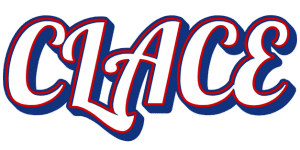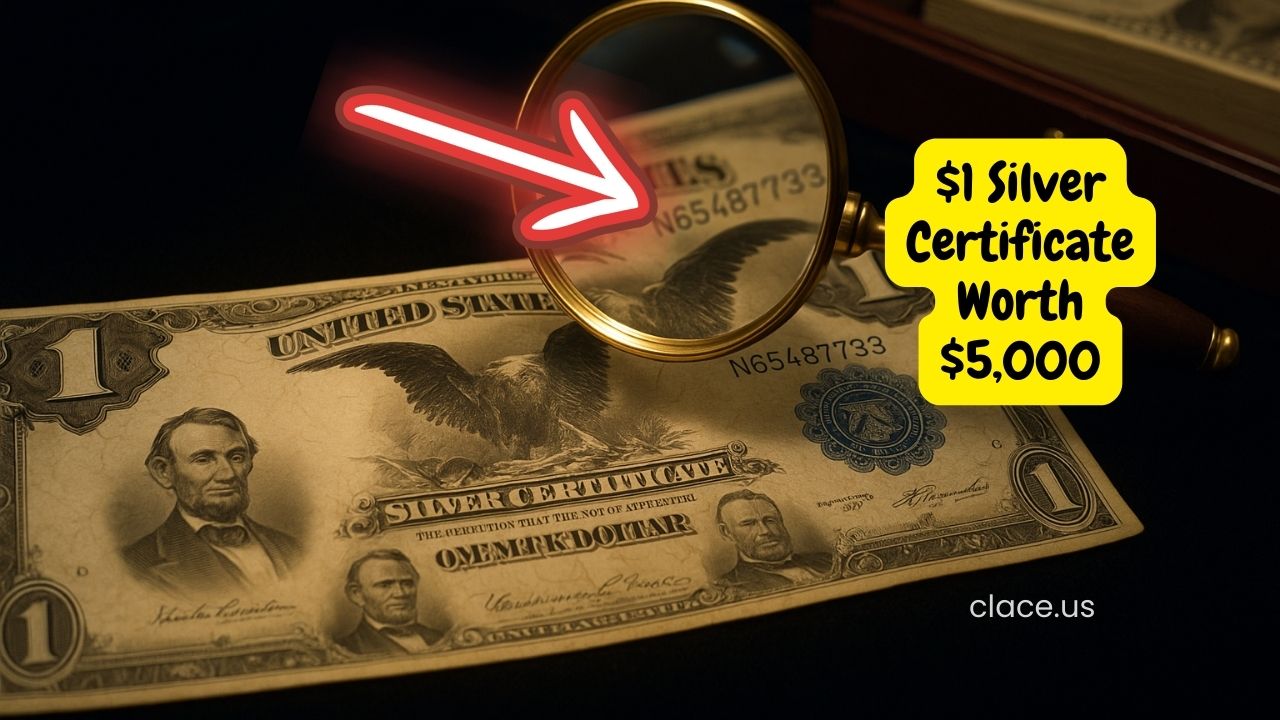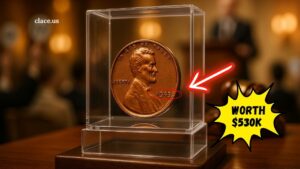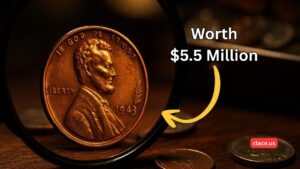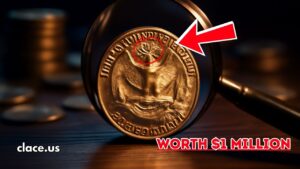Rare $1 Silver Certificate From 1899 Worth Over $5,000 Today
The 1899 $1 Silver Certificate is one of the most sought-after collectible U.S. banknotes for currency enthusiasts and numismatists.
Known for its intricate design, historical significance, and limited circulation, this note has become a prized possession, with values exceeding $5,000 for well-preserved specimens.
This guide explores every aspect of the 1899 $1 Silver Certificate, from its history and features to market values and collecting tips.
History of the 1899 $1 Silver Certificate
The 1899 $1 Silver Certificate was part of the United States’ broader effort to stabilize its currency during the late 19th century. Issued under the Treasury Act of 1878, these certificates were backed by silver deposits held by the U.S. Treasury.
Unlike standard paper money, silver certificates promised the bearer could redeem the note for an equivalent amount of silver dollars, which made them a trusted form of currency.
The 1899 series is famously known as the “Black Eagle” note, due to its central portrait of Martha Washington on the $1 denomination.
However, smaller $1 notes sometimes featured other iconic designs emphasizing patriotic motifs, the U.S. Treasury seal, and ornamental scrollwork. This series of notes was printed by the Bureau of Engraving and Printing, employing advanced anti-counterfeiting techniques for the era.
Key historical points:
- Issued: 1899
- Series: 1899 $1 Silver Certificate
- Known as: “Black Eagle Note”
- Backing: Silver
- Main portrait: Martha Washington / United States emblem
- Purpose: Redeemable for silver dollars
Collectors often seek this series due to its unique design, historical context, and rarity in today’s market.
Design Features of the 1899 $1 Silver Certificate
The 1899 Silver Certificate $1 bill is widely recognized for its artistic engraving and complex design elements, which have contributed to its collectible status. Understanding these features helps collectors identify authentic notes and distinguish them from reproductions.
Front Features:
- Portrait: Centered Martha Washington portrait (or Black Eagle emblem)
- Serial Numbers: Printed in red or blue ink, varying based on the series and state
- Treasury Signatures: Signatures of the Treasurer of the United States and Register of the Treasury
- Design: Decorative scrollwork and security elements typical of late 19th-century U.S. currency
Back Features:
- Text: “One Dollar in Silver Payable to the Bearer on Demand”
- Ornamentation: Symmetrical scroll patterns and border designs
- Security Elements: Intricate lines and patterns designed to prevent counterfeiting
Dimensions: Approximately 7.375 inches x 3.125 inches, slightly smaller than modern notes.
Rarity and Collector Demand
The 1899 $1 Silver Certificate is rare because most notes were redeemed for silver and subsequently destroyed. Surviving specimens are typically found in well-maintained collections, auctions, or estate sales. The rarity of these notes has increased their market value dramatically.
Factors affecting rarity and demand:
- Condition (grading): Notes in uncirculated or near-uncirculated condition are most valuable.
- Signatures and serial numbers: Unique or low serial numbers can add thousands of dollars to the note’s value.
- Printing errors: Misprints or variations can create extreme collector interest.
Grading Scale
Professional grading companies evaluate Silver Certificates using the PMG (Paper Money Guaranty) or PCGS Currency grading scales:
| Grade | Description | Typical Market Value |
|---|---|---|
| Poor (P) | Heavily circulated, torn, or stained | $500 – $800 |
| Fine (F) | Moderate wear, visible folds, minor tears | $800 – $1,500 |
| Very Fine (VF) | Moderate circulation, minor edge wear | $1,500 – $3,000 |
| Extremely Fine (EF/XF) | Minimal wear, crisp note | $3,000 – $5,000 |
| Uncirculated (UNC) | Perfect condition, no folds, original color | $5,000 – $10,000+ |
Collectors pay top dollar for high-grade examples, especially those certified by reputable agencies.
Current Market Value
As of 2025, the 1899 $1 Silver Certificate is estimated to be worth $5,000 to over $10,000, depending on the condition, rarity, and auction demand. Notes with exceptional features such as low serial numbers, star notes, or unusual signatures can fetch significantly more.
Auction Highlights (Recent Sales 2024-2025):
| Auction Date | Grade | Sale Price | Notable Feature |
|---|---|---|---|
| March 2024 | XF | $5,500 | Rare red seal, minimal wear |
| July 2024 | UNC | $8,200 | Star note with low serial number |
| December 2024 | EF | $6,000 | Exceptional centering and crisp edges |
| January 2025 | UNC | $10,500 | Unique misprint on Treasury seal |
Collectors should note that prices fluctuate based on market trends, scarcity, and collector interest.
Tips for Buying and Selling 1899 Silver Certificates
Whether buying for investment or selling, careful evaluation is critical to maximize value:
- Authentication: Always verify authenticity with a professional grading service like PCGS or PMG.
- Condition: Look for notes with minimal folds, stains, or tears. Even small imperfections can impact the value drastically.
- Provenance: Notes with a documented history or previous ownership in high-profile collections often sell for higher prices.
- Auction vs Private Sale: High-end notes often achieve the best prices in prestigious auctions rather than casual online marketplaces.
- Avoid Reproductions: Modern reproductions and novelty notes can resemble the 1899 series, so expert verification is essential.
Collecting Significance
Owning an 1899 $1 Silver Certificate is not just an investment; it represents a piece of American history:
- Historical Legacy: These notes are relics of the U.S. silver standard era, a key part of the nation’s financial development.
- Artistic Merit: Engravings and intricate designs showcase the craftsmanship of late 19th-century currency.
- Numismatic Prestige: Collectors of high-grade paper money often view this certificate as a cornerstone of any serious collection.
Factors Impacting Value in 2025
Several current trends and factors influence the value of the 1899 $1 Silver Certificate today:
- Numismatic Market Trends: Growing collector interest has pushed values higher over the past five years.
- Economic Uncertainty: Paper currency and collectibles often increase in value during times of economic instability.
- Rarity of High-Grade Notes: Notes in UNC or EF condition are increasingly scarce, boosting auction prices.
- Special Features: Star notes, unique serial numbers, or unusual signatures can add 50-100% premium over standard notes.
The 1899 $1 Silver Certificate is more than just paper money—it is a historical artifact, an investment, and a collectible treasure. With values surpassing $5,000 in today’s market, it remains a sought-after note for collectors worldwide. Understanding its history, design, rarity, grading, and market dynamics can help enthusiasts make informed decisions and potentially secure a valuable addition to their collection.
Whether buying, selling, or simply admiring, this note exemplifies the allure of American numismatics. For anyone interested in historical currency or investment-grade collectibles, the 1899 $1 Silver Certificate is a must-have gem.
FAQs
Its historical significance, limited surviving notes, and intricate design make it highly sought-after among collectors. High-grade or star notes fetch top market prices.
The value depends on condition, rarity, serial numbers, and market demand. Professional grading by PMG or PCGS is recommended for accurate appraisal.
High-quality notes are best purchased or sold through reputable auctions or certified dealers specializing in collectible U.S. currency.
